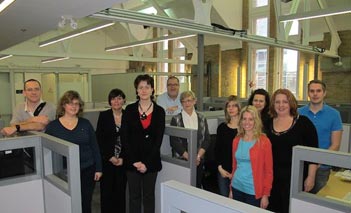A Move to Higher Ground

James Rutka
|
After more than 80 years of
continuous occupancy on
the third floor of the Banting
Institute at 100 College Street
West, on March 21st, 2013, the
Department of Surgery moved
its offices to the 5th and 6th
floors of the Stewart Building,
at 149 College Street West. Both
the occupancy at the Banting,
and the move to the Stewart
Building can be construed as historic at this time for the
reasons I will outline below.
Many of you will remember that Sir Frederick
Banting trained initially as a surgeon in the Department
of Surgery before becoming totally immersed in the
project to discover insulin - the lifesaving hormone from
the endocrine pancreas used to treat diabetes. Following
the discovery of insulin in May 1923 by Banting and
Charles Best, the Province of Ontario passed the Banting
and Best Medical Research Act providing annual funding
to the Board of Governors at the University to
establish the Banting and Best Research Fund. This
enabled the creation of the Banting and Best Chair of
Medical Research, of which Banting was the first holder
and the first research professor in Canada (1). In 1928,
the University agreed to provide space for both basic
and applied research for the physicians at the Toronto
General Hospital (TGH), and this space became the
“Banting Institute” across the street from TGH.
The Banting Institute was opened on September 16th,
1930. At the time of its opening, the Banting Institute
was large enough to house many Departments including
Pathology and Bacteriology, Pathological Chemistry,
Medicine, Obstetrics and Gynecology, Ophthalmology,
Otolaryngology, and Surgery. Lord Moynihan of Leeds,
President of the Royal College of Surgeons of England,
gave the opening address, and unveiled a portrait of
Joseph Lister that had been given to the College by two
former house surgeons who worked with Lister, Dr’s F
Lem. Grasset, and Dr H. St. George Baldwin. In the
same room as the portrait at the Banting Institute was
a brick removed from Lister’s Ward in the Old Glasgow
Royal Infirmary, under which there was a suitable
inscription which reads “A brick from Lister’s Ward in
the Royal Infirmary, Glasgow, presented by Professor
Irving H. Cameron”. Professor Cameron was a distinguished
Canadian surgeon on the Faculty of Medicine at
the University of Toronto, and one of the founders and
early editors of the Canadian Journal of Medical Sciences.
Those of you who have spent time at the Banting in the
Department of Surgery’s 3rd floor offices will recall seeing
both the portrait of Lister, and the brick inscribed by
Professor Cameron.
The Department of Surgery at the Banting was confined
to limited office space until the tenure of Donald R
Wilson as Chair (1972-82). Dr Wilson created and developed
the boardroom and the Chair’s office that remained
in place until 2013. Over the years, the Department of
Surgery managed to acquire additional office space for
the Postgraduate and Undergraduate Medical Education
efforts, and for some of the Divisions including General
Surgery, Orthopaedics, and Plastic and Reconstructive
Surgery. But these offices were not contiguous, and were
on different floors than the Chair’s office.
|
I can distinctly remember meeting with Dr Bernard
Langer, Chair of the Department of Surgery (1982-92),
at the Banting when I was a resident in neurosurgery in
the 1980’s. I recall the dark wood paneling of the Chair’s
Office, and the heavyset furniture within, reminiscences
of a bygone era in academic medicine and surgery.
It was soon after I became Chair in 2011 that Dean
Catharine Whiteside informed me that the Department
of Surgery must leave the Banting Institute. But where?
Interestingly, all the Chairs since Bernard Langer had
been told the same thing about the requirement to leave
the Banting Institute.
Thankfully, the Dean identified space for the
Department of Surgery on the 5th and 6th Floors of
the Stewart Building which was built in 1894 by John
Beverley Robinson, former Mayor of Toronto and
Lieutenant Governor of Ontario. An amateur boxer,
John Robinson converted the initial building into the
Toronto Athletic Club. From 1931 – 1957, the Stewart
Building served as the Toronto Police Headquarters,
and from 1979 – 1997, it became the second campus of
the Ontario College of Art and Design. Currently, the
Stewart Building is primarily occupied by the offices of
the Rotman School of Management of the University of
Toronto.

The Surgery staff in our lofty new location.
I hope all of you will come visit us in our new space.
In the Stewart Building, we are situated all together in
one large space which provides a degree of cohesiveness
and camaraderie that was not possible at the Banting. In
addition, you will be pleased to know, we have found a
home for the magnificent portrait of Lister which has
made the journey from the Banting Institute!
James T Rutka,
RS McLaughlin Professor and Chair
1. Shorter, N, Partnership for Excellence: Medicine at the
University of Toronto and Academic Hospitals, In Press, 2013
|